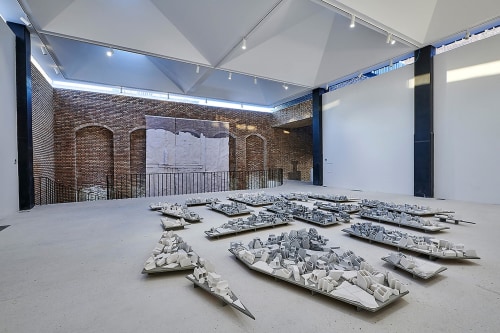
Nazgol Ansarinia, The mechanisms of growth, Demolishing buildings, buying waste, 2017
Plaster, glue, pigment, Dimensions variable
To find a pattern in the art of repetition is a subtle invitation to critique the nature of the order of things, largely (in)visible in the world driven by urbanity and mass consumerism. The element of recurrence if at once is attentive to the ideas of authenticity and appropriation, it also raises emphasis on the objects of everyday existence, which are otherwise rendered with minimal significance. In the hands of the Tehran-based artist, Nazgol Ansarinia, the layers of repetition in her art, dominated by architectural components and design serves as a conceptual means to revisit the urban landscape of her city through the narrative of collective memory and desires.
In the sculpture The Mechanisms of Growth by Ansarinia, the element of repetition is a key: it is a creative strategy to symbolically represent the cyclic order crucial to urban development. The capital of Iran, Tehran, has seen an exponential rise of gentrification: as part of the process, old housing structures are razed down to the ground to pave the way for new infrastructures. For Ansarinia it is not a one-time phenomenon, but a task pinned to a circle of continuation. The cycle is not limited to the practice of creation-annihilation, deconstruction-reconstruction, generation-degeneration, but extends itself to the material of the built environment - it is often given a new life during the process of building new structures.
The host of sculptures in The Mechanisms of Growth acutely refrains from recreating the world of perfection, which remains unattainable in the real-life scenario. The array of demolished buildings, with a running similarity in terms of shape and design, are hoarded to reassemble the scene from the streets of Tehran. The debris to which these miniature-sized “demolished buildings” refer to, is an erasure of Ansarinia’s memory of the city. The damage to the cityscape carries with it a feeling of being “lost when you can’t relate to space,” she mentions in a video The Artist and their City by The Guardian / Tate. The installations with their seamless (ir)regular patterns cajole the viewers to take a pause in an effort to gauge the effects of hasty transitions from the past to the present, and what does future hold against the backdrop of such events.
...
The variety of materials including plaster, resin, paper, silicon and wax as well as digital media available in her practice do justice to the expanse of ideas and themes in the works. The biggest challenge for her is to find the material to do what she needs to do. Since Ansarinia is not a trained fine artist, the techniques that give final form to the works are the result of thorough experimentation and exchange between artist and architect friends. Ansarinia accepts since, “Each material and technique has its own language and limitations, so I switch to what suits the work.”
Given the rich history and research that motivates the works of the artist Ansarinia, one is pleasantly surprised to encounter the delicacy of repetition peppered by minimalism with which she translates her ideas into a tangible reality laced by an aesthetic appeal. With the uncommon finesse found in the works, Ansarinia hopes that “the audience walks away rethinking about a subject they thought was familiar and mundane”.